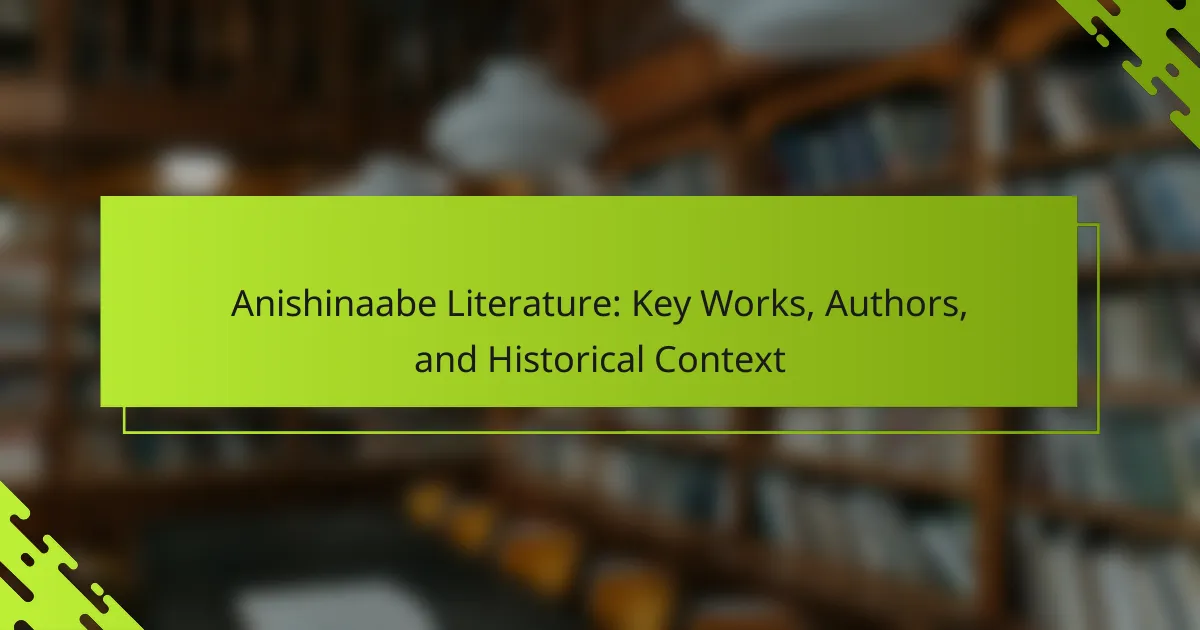Anishinaabe literature offers profound insights into identity, connection to nature, and oral traditions. This article explores key works and prominent authors like Louise Erdrich and Gerald Vizenor, highlighting their contributions to cultural representation. It also examines the historical context that shapes these narratives and the unique storytelling styles that define Anishinaabe literary expression. Understanding these elements enriches appreciation for the resilience and adaptability of Anishinaabe culture.

What are the foundational themes in Anishinaabe literature?
Anishinaabe literature encompasses themes of identity, connection to nature, and oral tradition. These foundational themes reflect the cultural values and historical experiences of the Anishinaabe people. The literature often explores relationships with the land, spirituality, and the importance of storytelling. Key works highlight the resilience and adaptability of Anishinaabe culture amidst historical challenges.
How do oral traditions influence Anishinaabe storytelling?
Oral traditions significantly shape Anishinaabe storytelling by preserving cultural identity and historical narratives. These traditions emphasize the importance of community and shared experiences, ensuring that stories are passed down through generations. Anishinaabe stories often incorporate elements of nature, spirituality, and moral lessons, reflecting the unique worldview of the community. The oral format allows for dynamic storytelling, where the storyteller adapts the narrative to engage the audience, making each telling a unique experience. This practice not only reinforces cultural values but also fosters a sense of belonging among the Anishinaabe people.
What role does spirituality play in Anishinaabe narratives?
Spirituality plays a central role in Anishinaabe narratives, influencing themes, characters, and storytelling techniques. Anishinaabe literature often reflects spiritual beliefs, emphasizing connections to nature and the importance of ancestral wisdom. These narratives serve not only as entertainment but also as vehicles for cultural teachings and moral lessons. Spiritual elements manifest through symbolism and traditional teachings, reinforcing the community’s identity and values.
Which cultural symbols are prevalent in Anishinaabe texts?
Cultural symbols prevalent in Anishinaabe texts include water, the eagle, and the maple tree. These symbols represent essential values such as spirituality, freedom, and life. Water symbolizes purification and connection to ancestors. The eagle signifies strength and vision, often seen as a messenger to the Creator. The maple tree represents sustenance and community, reflecting the importance of nature in Anishinaabe culture. These symbols enrich the narratives and convey deeper meanings in Anishinaabe literature.

Who are the prominent authors in Anishinaabe literature?
Prominent authors in Anishinaabe literature include Louise Erdrich, Gerald Vizenor, and Heid E. Erdrich. These writers have significantly contributed to the representation of Anishinaabe culture and identity through their storytelling. Louise Erdrich, known for her novels, often weaves traditional narratives with contemporary themes. Gerald Vizenor, a key figure in Native American literature, explores concepts of survivance and identity in his works. Heid E. Erdrich, a poet and essayist, focuses on the intersection of personal and cultural narratives. Collectively, they highlight the richness of Anishinaabe literary traditions.
What are the key works of Louise Erdrich and their impact?
Louise Erdrich’s key works include “Love Medicine,” “The Round House,” and “The Birchbark House.” These novels explore Anishinaabe culture, identity, and history, significantly impacting Native American literature. “Love Medicine” intertwines multiple narratives, showcasing the complexity of family and community ties. “The Round House” addresses themes of justice and trauma, reflecting contemporary Indigenous issues. “The Birchbark House” serves as a children’s entry point into Anishinaabe life, emphasizing cultural heritage. Erdrich’s storytelling fosters greater understanding of Indigenous experiences and challenges stereotypes.
How does the writing of Gerald Vizenor reflect Anishinaabe identity?
Gerald Vizenor’s writing profoundly reflects Anishinaabe identity through themes of survival, resilience, and cultural revitalization. His narratives often incorporate traditional Anishinaabe stories and philosophies, emphasizing the importance of language and storytelling in preserving identity. Vizenor’s unique attribute is his use of humor and irony, which challenges stereotypes and engages readers in a deeper understanding of Anishinaabe culture. His works, such as “Griever: An American Monkey King in China,” showcase the blending of contemporary issues with traditional values, reinforcing the dynamic nature of Anishinaabe identity.
Which emerging authors are shaping contemporary Anishinaabe literature?
Emerging authors shaping contemporary Anishinaabe literature include Louise Erdrich, Heid E. Erdrich, and Tasha Spillett. Their works reflect Anishinaabe culture, identity, and contemporary issues. Louise Erdrich’s novels often blend personal and historical narratives, while Heid E. Erdrich focuses on poetry and storytelling that honors traditional Anishinaabe themes. Tasha Spillett’s writings emphasize the importance of Indigenous voices in education and activism. These authors contribute significantly to the evolving landscape of Anishinaabe literature, highlighting both root and unique attributes of their cultural heritage.

How has historical context shaped Anishinaabe literary expression?
Historical context has profoundly influenced Anishinaabe literary expression by intertwining cultural heritage with contemporary themes. The trauma of colonization and the resilience of Indigenous identity are central to many works. Authors like Louise Erdrich and Gerald Vizenor incorporate traditional storytelling methods, reflecting the unique attributes of Anishinaabe culture. Their narratives often address historical injustices while celebrating community and spirituality. As a result, Anishinaabe literature serves as a powerful medium for cultural preservation and social commentary.
What influences did colonialism have on Anishinaabe literature?
Colonialism significantly influenced Anishinaabe literature by shaping themes, narratives, and cultural expressions. The impact includes the introduction of new genres, the incorporation of European literary forms, and the exploration of identity and resistance. Anishinaabe writers often reflect the struggle to preserve their heritage amidst colonial pressures. Works such as “The Mishomis Book” by Edward Benton-Banai illustrate these themes, blending traditional stories with contemporary issues. This fusion highlights the resilience of Anishinaabe culture while addressing the complexities of colonial history.
How do historical events appear in Anishinaabe literary works?
Historical events prominently feature in Anishinaabe literary works, reflecting cultural identity and resilience. These narratives often recount the impact of colonization, treaties, and cultural displacement. Authors like Louise Erdrich and Gerald Vizenor weave historical context into their storytelling, illustrating the struggles and triumphs of the Anishinaabe people. Their works serve as a medium for preserving history and promoting awareness of Indigenous experiences. Through poetry, novels, and oral traditions, Anishinaabe literature captures the essence of historical events and their ongoing relevance today.

What are the unique narrative styles found in Anishinaabe literature?
Anishinaabe literature features unique narrative styles that blend oral traditions with contemporary storytelling. These styles often include cyclical narratives, where stories reflect the interconnectedness of life, and the use of metaphorical language that evokes natural imagery.
Authors like Louise Erdrich and Gerald Vizenor incorporate personal and communal experiences, emphasizing identity and cultural resilience. The use of humor and non-linear timelines are also prevalent, offering diverse perspectives on history and existence.
Moreover, storytelling serves as a means of preserving language and cultural heritage, making it a vital aspect of Anishinaabe literature. The integration of traditional teachings into modern narratives highlights the adaptability and continuity of Anishinaabe voices.
How do metafictional elements manifest in Anishinaabe texts?
Metafictional elements in Anishinaabe texts often reveal the interplay between storytelling and cultural identity. These elements manifest through self-referential narratives and the blending of traditional oral storytelling with contemporary themes. Authors like Louise Erdrich and Tomson Highway utilize metafiction to explore the complexities of Anishinaabe identity and history. This technique engages readers in a dialogue about the nature of storytelling itself, emphasizing the significance of perspective and voice in indigenous literature.
Which forms of poetry are distinctive to Anishinaabe writers?
Anishinaabe writers are known for their distinctive forms of poetry, including traditional oral storytelling and contemporary written verse. These forms often reflect cultural themes, spiritual beliefs, and connections to nature. Anishinaabe poetry frequently employs imagery, metaphor, and symbolism rooted in the community’s history and identity. Unique attributes include the use of the Anishinaabe language, which enhances cultural authenticity and emotional resonance. Notable poets like Louise McNeil and Gordon Henry Jr. exemplify this rich poetic tradition, contributing significantly to the landscape of Indigenous literature.

How is Anishinaabe literature received and interpreted globally?
Anishinaabe literature is received and interpreted globally through diverse perspectives that highlight its cultural significance. Key works by authors like Louise Erdrich and Gerald Vizenor emphasize themes of identity and resilience. The historical context of Anishinaabe storytelling enriches these interpretations, showcasing the interplay of tradition and contemporary issues. Global audiences appreciate the unique narrative styles and the incorporation of oral traditions, which differentiate Anishinaabe literature from other literary forms. As a result, this literature fosters cross-cultural dialogue and enhances understanding of Indigenous experiences.
What challenges do Anishinaabe authors face in the literary market?
Anishinaabe authors face significant challenges in the literary market, including cultural misrepresentation and limited access to publishing resources. These issues often hinder their ability to reach broader audiences. Additionally, there is a struggle to maintain cultural authenticity while appealing to mainstream market demands. The lack of representation in literary awards and media further complicates their visibility.
How do translations affect the understanding of Anishinaabe works?
Translations can significantly influence the understanding of Anishinaabe works by altering cultural nuances and contextual meanings. These translations may lose unique attributes inherent to the original language, which can lead to misinterpretations. For example, specific cultural references may not have direct equivalents in English, affecting the reader’s comprehension. Additionally, the choice of words in translation can either enrich or dilute the text’s emotional depth and cultural significance. As a result, readers may miss essential aspects of Anishinaabe identity and worldview that are embedded in the original language.

What are the best practices for engaging with Anishinaabe literature?
Engaging with Anishinaabe literature involves understanding its cultural significance and historical context. Readers should approach the texts with respect for Indigenous perspectives and traditions.
Key practices include familiarizing oneself with the oral storytelling traditions that influence written works. Acknowledging the contributions of notable authors like Louise Erdrich and Gerald Vizenor enhances appreciation. Additionally, exploring themes of identity, community, and spirituality in the literature provides deeper insights.
Participating in community discussions or attending literary events can enrich the engagement experience. Lastly, considering the impact of colonization on Anishinaabe narratives is crucial for a comprehensive understanding of the literature.
How can readers appreciate the cultural context of Anishinaabe texts?
Readers can appreciate the cultural context of Anishinaabe texts by understanding their historical roots and contemporary significance. Anishinaabe literature reflects the values, traditions, and experiences of the Anishinaabe people. Engaging with these texts requires awareness of their oral storytelling traditions and the impact of colonization.
Exploring key works, such as those by authors like Louise Erdrich and Gerald Vizenor, reveals the unique attributes of Anishinaabe narratives. These works often incorporate themes of identity, resilience, and connection to the land. Readers should also consider the role of language, as many texts are infused with Anishinaabe words and phrases that enrich their meaning.
Furthermore, recognizing the cultural practices surrounding storytelling enhances appreciation. Anishinaabe literature often serves as a medium for cultural preservation and education, making it essential for readers to approach these texts with respect and openness. Understanding these layers fosters a deeper connection to the narratives and the community they represent.
What common mistakes should be avoided when interpreting Anishinaabe literature?
Common mistakes to avoid when interpreting Anishinaabe literature include oversimplifying cultural contexts, neglecting oral traditions, and misrepresenting themes. Understanding the historical significance and the unique worldview of the Anishinaabe people is crucial. Readers often overlook the depth of symbolism and the role of storytelling. Additionally, failing to recognize the impact of language nuances can lead to misinterpretations. Engaging with authentic sources and respecting the cultural heritage enhances comprehension.
